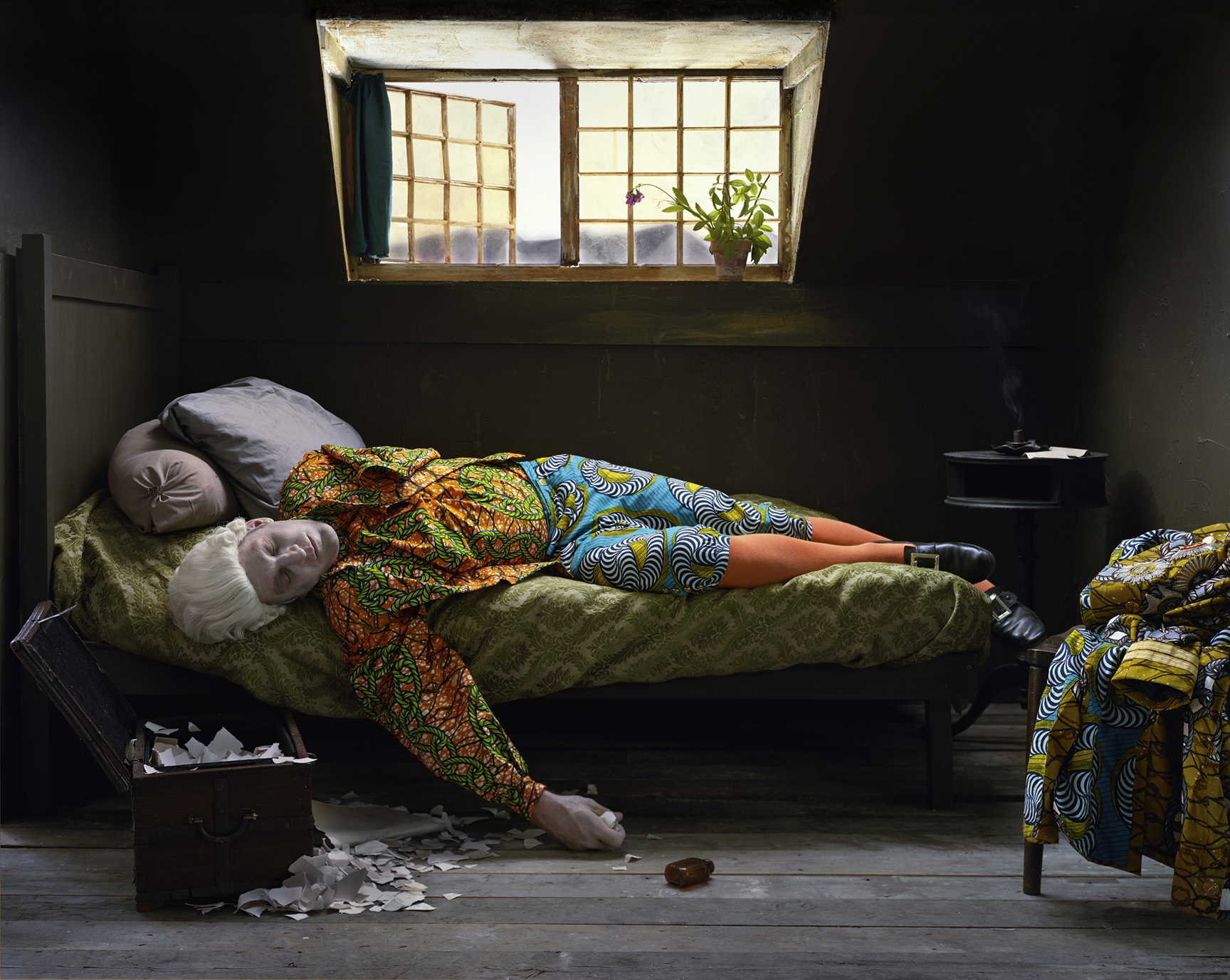
Exiting the elevator on the second floor of the Yale Center for British Art, one is confronted with a triptych containing a three-dimensional reconstruction of the gunport of a ship, adapted to the colors of a children’s playground. Behind this wall is the Shonibare exhibit. One gets the feeling of having gone through the gunport to find the captain’s quarters, fully decorated in maritime style, right down to a ship maquette inside a glass bottle.
Yinka Shonibare is a British-Nigerian artist who was commissioned to create a commemorative piece honoring Admiral Lord Nelson’s victory in the Battle of Trafalgar, the deciding naval battle which ended the Napoleonic dream of invading Britain. The piece he made for Trafalgar Square in London was a much bigger version of the ship found in the exhibition. The idea is the same though: make a scale-replica of the Admiral’s famous ship HMS Victory, put it inside a glass bottle, cork it up and put on display. But also, make sure to exchange the imperial white sails for colorful scraps found rummaging through a grandma’s dusty old clothes. This last step is crucial for viewers who have a hard time differentiating between the decorative value of ship models versus their identity as objects of art. Another thing that helps the case for an art object is that the grandma scraps are in fact special-order Dutch wax-printed fabrics, Shonibare’s signature material.
Inside the glass bottle, the ship sits on a calm, artificial sea made of a material that seems closest to grape jelly at first inspection. It is more suited for a toddler’s collection of pirate ships than an executive’s office — which is the space one imagines most ship models to inhabit after they have been assembled and sealed.
The ambiguity of belonging is a central theme in the exhibition. On one wall is a self-portrait of the artist himself, a black and white photograph with a face covered in orange veins. Locks of his hair stick up from his scalp, giving him the air of a man who might or might not be fully sane. The styling makes sense once one finds out that the work is based on Andy Warhol’s self-portrait, in which he clearly did not mean to perceived as sane.
On the wall opposite, there are three of the five “Fake Death Pictures.” A man, in fact the same man in all, is committing suicide in each photograph, once by poison, once by gunshot and once by the blade of a dagger. The man wears the same clothes throughout, Victorian in style but not in fabric. The coat is yellow and has glittery pins on the left chest, the pants are cyan blue, the stockings a shocking orange. Between his head covered in a side-curled white wig and his feet in proper black shoes, the man seems to have been subjected to an unsupervised kindergarten coloring party.
The three scenes themselves are exact replicas of well-known suicide paintings done by artists of the 19th century: poison is “The Death of Chatterton” by Henry Wallis, the gun is “Le Suicide” by Eduard Manet and the dagger is, fittingly, the “Satire of the Romantic Suicide” by Leonardo Alenza. However, these photos aren’t only recreating the scenes from the original paintings: they are re-imagining them as Admiral Lord Horatio Nelson’s own suicide, by replacing the subject of each painting with Nelson.
The actor in the unorthodox Victorian costume stands in for the admiral, who in turn stands in for the subjects of the original paintings. The photographs therefore are twice removed from reality, and have no apparent reference to the admiral’s actual death, which was in battle on top of a ship. Shonibare imagines that Nelson has not died as a war hero once, but has taken his life five different ways.
At issue is not just the glorification of war heroes, but the conundrum of identity itself: if this image of Nelson can suffer the deaths of others, does it even matter that it is Nelson we are looking at? Especially since he is portrayed by yet another actor, whose dress and manner are incongruent with Nelson’s true self.
The final pieces of the exhibit are two full outfits “preserved” in glass cases. One of them is the now-easily recognizable yellow coat from the suicide scenes, the other is a dress for the admiral’s female companion. Again, they are perfectly sewn for the Victorians, yet the seamstress who executed them seems to have had access only to the signature Dutch wax fabrics of Shonibare. This is an alternate universe where the forms are familiar but the color scheme is inverted. The woman’s gown especially seems too garish even for today’s fashionistas, with hot pink sleeves and palm-sized flowers gracing the skirt. Seeing the clothing without a body inside is almost like seeing the backstage of a performance. The sense that what Shonibare made the admiral wear in the “Fake Deaths” were merely character costumes, not specific to Nelson and could be inhabited by anyone willing to take his place. After learning that all the original-seeming pieces are in fact based on previous work by other artists, one questions the authenticity of the work. Shonibare’s exhibit is better viewed as if in a theater, where it is perfectly acceptable to direct a well-known play written by another and still claim it as one’s own.







